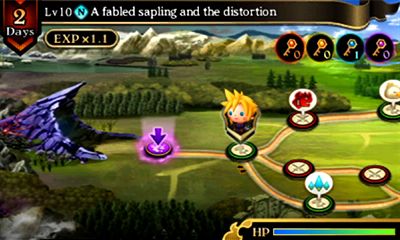Theatrhythm Final Fantasy: Curtain Call: The System That Smothers
Whether you came to the Final Fantasy series early or late, whether your favorite female heroine is Terra or Lightning, one thing that unites all series fans is an appreciation for the excellent music that’s been a hallmark of the franchise since the start. Multiple composers, including Hitoshi Sakimoto and Masashi Hamauzu have upheld the musical standard of quality established by Nobuo Uematsu, who wrote the memorable themes that still persist in the games today, such as the series’ Prelude, Main Theme, and Chocobo melody. Theatrhythm Final Fantasy: Curtain Call is an homage to that musical legacy, packing a couple hundred songs from over two dozen entries in the overarching franchise on the cartridge for fans to play in a rhythm game that challenges their knowledge and mastery of the scores. Yet for all this is meant to be a celebration of the music, there’s an odd fear that pervades the game that the music isn’t enough to drive a game. That, as with any game in the modern era, there needs to be more. The result of this process is a game that venerates its own scaffolding as much as what that scaffolding is latticed over; a system that exists to justify the implementation of a system.
 To Theatrhythm’s credit, this isn’t the case when you power on the game. The first and only mode available on a new save file is the ability to play one-off songs (or Music Stages), and although there are a great deal of unlocks and rewards as you “progress,” comparatively few actual songs are locked away. For the most part, you have free reign from the start to graze through the full selection of songs, trying out your most beloved tunes here and there, then maybe advancing to some of the deeper or less-remembered cuts. It might seem weird at first that before doing this, you have to select starting characters, form a party with them, and choose their ability loadout before doing so, but the process only takes a few minutes before it’s just you and the songs.
To Theatrhythm’s credit, this isn’t the case when you power on the game. The first and only mode available on a new save file is the ability to play one-off songs (or Music Stages), and although there are a great deal of unlocks and rewards as you “progress,” comparatively few actual songs are locked away. For the most part, you have free reign from the start to graze through the full selection of songs, trying out your most beloved tunes here and there, then maybe advancing to some of the deeper or less-remembered cuts. It might seem weird at first that before doing this, you have to select starting characters, form a party with them, and choose their ability loadout before doing so, but the process only takes a few minutes before it’s just you and the songs.
Except it isn’t. Even in this mode, after each song there’s a results screen where various stats and gauges increase. (I’ve called these number-go-up ever since a friend expressed his appreciation for this kind of mechanic by saying, “The numbers go up and Austin claps.”) Here are the things Theatrhythm, a rhythm game about hitting buttons in time with your favorite Final Fantasy music, asks you to pay attention to:
-Your total “Rhythmia,” the amount of positive energy you’re funnelling into the good goddess Order to fuel her struggle with Chaos. This is the number-go-up that unlocks new songs, wallpaper, slogans, sound effects, song players, and sometimes characters.
-Your party’s levels and stats. The better you do on a song, and the harder that song was, the most experience you accrue, which in turn raises their stats so that your characters’ Strength, Magic, Agility, Luck, Stamina, and Spirit numbers can also go up.
-Your party’s skills. Some of these skills are tailored to a particular type of song, of which the game has two: battle songs and field songs. (Or “BMS” and “FMS” respectively, because Theatrhythm will never settle for something simple when it could be jargonized instead.) Damaging spells are good for the BMS stages, while distance and speed-related skills are best for FMS. The game makes a point of noting that none of these skills directly increase your score, the one number you’d think would matter to have go up.
-Your equipment. Granted, you can only have one item equipped at a time, but Theatrhythm will keep throwing them at you at the end of each stage, and each item is one-use-only, encouraging you to keep switching it out after each song. The items do things like heal your party (who take damage on missed notes), teach new skills, or buff up the summon spells that are cast during a special segment of each BMS stage.
 All of this comes to a head when you’ve played enough Music Stages for the game to unlock Quest Medleys. Like the stat-heavy scaffolding around the simple musical homage that makes up the main game, Quest Medley mode takes a good idea–randomized playlists, in this case–and adds so much bric-a-brac that the point of the exercise is buried. Each Quest Medley, which come in short, long, and grueling variants, plot a course of song nodes along a map, which features branching paths, secret bosses, hidden treasure, and potential shortcuts. “A-ha,” you’ll say upon embarking on your first Quest Medley. “This is what I was building that party for.” Quest Medleys are the overly elaborate system that was built to carry all the game’s other overly elaborate systems.
All of this comes to a head when you’ve played enough Music Stages for the game to unlock Quest Medleys. Like the stat-heavy scaffolding around the simple musical homage that makes up the main game, Quest Medley mode takes a good idea–randomized playlists, in this case–and adds so much bric-a-brac that the point of the exercise is buried. Each Quest Medley, which come in short, long, and grueling variants, plot a course of song nodes along a map, which features branching paths, secret bosses, hidden treasure, and potential shortcuts. “A-ha,” you’ll say upon embarking on your first Quest Medley. “This is what I was building that party for.” Quest Medleys are the overly elaborate system that was built to carry all the game’s other overly elaborate systems.
I won’t pretend I didn’t have fun with it, or that I wasn’t excited to take those characters I’d put a few levels into on their first Quest Medley. I dutifully swapped my characters’ loadout between BMS and FMS stages to optimize gains, experimented with different party members to get a feel for who could contribute what, and planned my route through each Quest Medley carefully to hit all the secret boss nodes for their special Crystal Shard rewards that went toward unlocking new characters. I did all the things you generally do in RPGs, because I like RPGs and this was a mode that, on its face at least, was carrying forward the Final Fantasy tradition in another way.
But Theatrhythm isn’t an RPG, not really. There are two key differences between the Quest Medley experience and the Final Fantasy games it’s derived from. One is the absence of a story in Theatrhythm. After gaining a certain amount of Rhythmia, there is a final boss fight, but whether you gain that Rhythmia by playing one-offs or grinding Quest Medleys, there’s no plot progression to match the character progression. In its absence, I was forced to question what all my gains were for. Was I really just playing to make the numbers go up? If appreciation of the songs is the real point, is distracting the player with illusory advancement the best way to make that point?
 The other, more important difference, is that the way a player engages with an RPG is through those character enhancement systems. In an RPG, you won’t win a tough fight unless you’ve put in the work of acquiring skills and coming up with a strategy to deploy them, or if all else fails, grinding until the numbers have gone up sufficiently to guarantee your victory. In Theatrhythm, though, the way you engage with the game is still to press buttons or tap the screen in time with the music. No amount of scaffolding can change this core interaction, however far it goes to obscure it. You’re either good at the songs or you’re not. For those who can’t manage to pass them even on the easiest difficulty level,grinding up enough levels for HP and curative spells might help you fail songs you’re otherwise hopeless at playing. But if the only value the system has is as a safety net for the inexperienced, there are surely other ways to design such a safety net that aren’t so needlessly, baroquely complex. (Nintendo’s golden leaves of the recent Mario games are one elegant example.)
The other, more important difference, is that the way a player engages with an RPG is through those character enhancement systems. In an RPG, you won’t win a tough fight unless you’ve put in the work of acquiring skills and coming up with a strategy to deploy them, or if all else fails, grinding until the numbers have gone up sufficiently to guarantee your victory. In Theatrhythm, though, the way you engage with the game is still to press buttons or tap the screen in time with the music. No amount of scaffolding can change this core interaction, however far it goes to obscure it. You’re either good at the songs or you’re not. For those who can’t manage to pass them even on the easiest difficulty level,grinding up enough levels for HP and curative spells might help you fail songs you’re otherwise hopeless at playing. But if the only value the system has is as a safety net for the inexperienced, there are surely other ways to design such a safety net that aren’t so needlessly, baroquely complex. (Nintendo’s golden leaves of the recent Mario games are one elegant example.)
At the heart of Theatrhythm is a well-made rhythm game which draws on a library of excellent music and executes well, with thoughtful, creative note charts that are well-balanced between the three difficulty modes. That’s what makes it especially sad that its creators lacked the confidence to make the game just that. The bolted-on morass of RPG elements make for good back-of-box bullet points, and may help to draw in those who wouldn’t otherwise be interested in a Final Fantasy rhythm game–but given what it’s meant to be honoring, why would those people want to play Theatrhythm in the first place? Why celebrate a vital tree by planting creeping vines to smother it?










